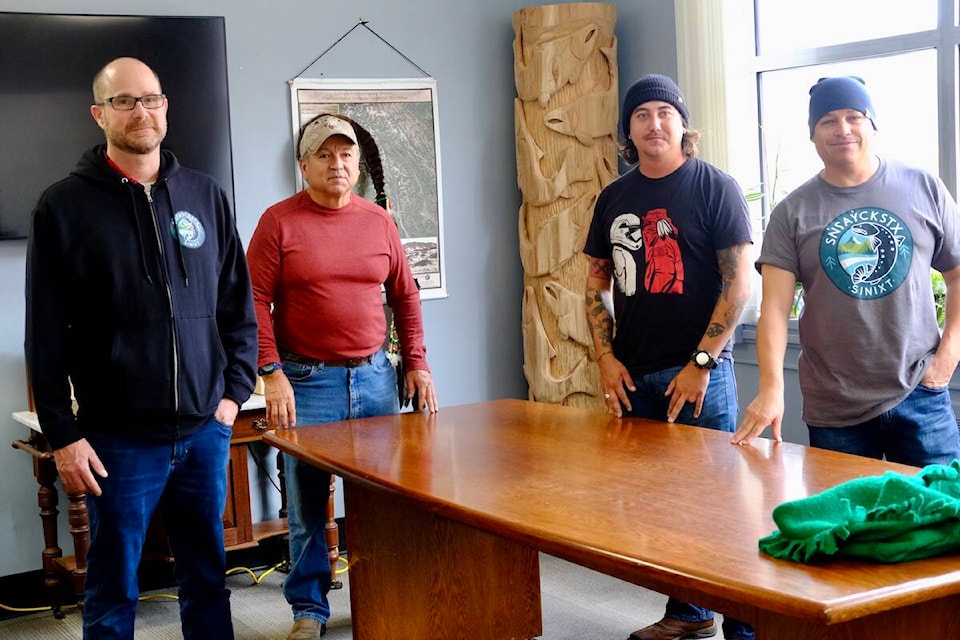The Sinixt Confederacy of the Washington State-based Colville Confederated Tribes now has an office in Nelson.
Located at 202-514 Vernon St., the office was officially opened on Oct. 25. It will be staffed by archeologist Remey Lacombe, policy advisor Herb Alex, biologist James Baxter, and outreach technician Rick Desautel.
They will focus on fish and wildlife issues in their Canadian territory, which stretches from the U.S. border to the bend in the Columbia River north of Revelstoke.
Following the 2021 decision of the Supreme Court of Canada that the Sinixt are now an “aboriginal people of Canada,” as defined by the Constitution of Canada, the Sinixt have stated that they expect the federal and provincial governments to treat them as such.
Alex said some government departments, businesses and organizations have begun to consult with them about natural resource issues, and he expects this to increase now that they have an office and a presence in Canada. He said the Sinixt Confederacy have created hunting and fishing regulations for the Sinixt people in Canada.
“We are up here to fulfill our responsibilities,” Alex said. “Our responsibilities are to the ecosystems. Our responsibilities are to everybody in this room, and everybody in this town, and everybody in this watershed and everybody in Sinixt territory. That’s how we view our responsibilities.”
Alex says he was born in Nelson of Sinixt descent, is a member of the Osoyoos Indian Band, and has worked in fisheries projects for Indigenous groups on both sides of the border.
“Having this presence here,” he said, “we will get people walking in and we’re talking to them on the street … So this connection to the community is huge. It can’t be understated.”
Baxter said the office staff will spend the winter settling in and writing project proposals to various funding groups including the Columbia Basin Fisheries Compensation Program, for fisheries conservation projects.
He said they will be reaching out and inviting local input on a variety of land use issues, and he gave the example of his upcoming fact-finding meeting with the owner of the Zincton ski resort near New Denver.
“How we are involved right now, is on the front lines of engagement,” he said. “And probably next spring you’ll see some fish and wildlife projects getting off the ground.”
Desautel said he has 27 years of experience working in fish and wildlife projects at the Colville Confederated Tribes and his outreach job in Nelson will involve going to community functions and to schools to teach and learn.
He was the American Sinixt man who was arrested for shooting an elk in B.C. in 2017, leading eventually to the Supreme Court of Canada decision that the Sinixt are an aboriginal people of Canada. In 1956, the federal government declared the Sinixt extinct in Canada, a declaration it has not rescinded since the Supreme Court’s Desautel decision.
At the Nelson Museum and Archives, Sinixt spokesperson Shelly Boyd presided over an opening ceremony for the new office.
“This is the first time we will have an actual place that is physically here,” she told the 150-to-200 people in attendance. “It’s a beautiful thing to see.”
She said that on the previous day she and others spent time fishing with some of their young children on the Lardeau River. For her, the experience embodied the idea of reconciliation.
“A whole bunch of our kids up here fishing and feeling welcome and loved when they are here.”
Autonomous Sinixt
During the ceremony, the Sinixt participants led the public on a procession out onto the sidewalk and then up the stairs to the new Sinixt office in the post office building next door. On the sidewalk they were greeted by about 25 people with signs, chanting, “Autonomy not confederacy.”
They were the supporters of Marilyn James, who heads the B.C.-based Autonomous Sinixt. James and the Sinixt Confederacy do not recognize each other’s right to speak for the Sinixt.
She was there to protest the opening of the office, James said, because the Colville Tribes and the Sinixt Confederacy do not represent Sinixt interests but rather the interests of government and industry.
“They do not care about the protection of the water, they do not care about the protection of the land,” she said, adding that Autonomous Sinixt are “following the traditional laws, offering a traditional form of government.”
She said federally recognized tribal governments are an operation of the federal government, which is “giving our resources, our land, to other tribal groups, and not dealing with the extinction issue. By Colville’s doing this, they are colluding in an act of genocide against Sinixt peoples.”
Museum agreement
During the ceremony in the museum, executive director Astrid Heyerdahl and Cindy Marchand, secretary of the Colville Confederated Tribes, signed a memorandum of understanding between the two organizations.
Heyerdahl said the agreement means that all Sinixt artifacts in the museum are now owned by the Sinixt Confederacy, even though they are housed in the museum. She said it also means that the museum will be the repository of any future artifacts.
“Working with BC Hydro, working with other government bodies, or any time there’s a dig of any kind, then we will connect with the Sinixt Confederacy and ensure that the objects go where the Sinixt people want them to go,” Heyerdahl said, adding that the museum in Revelstoke will be entering into a similar agreement for the northern part of Sinixt territory.
READ MORE
• Sinixt cry foul over Columbia River Treaty funding given to other Indigenous groups
• Agreement reached to share Columbia River Treaty revenues with First Nations
• ‘We’re still here’: Sinixt return to Nelson to celebrate anniversary of Supreme Court victory
